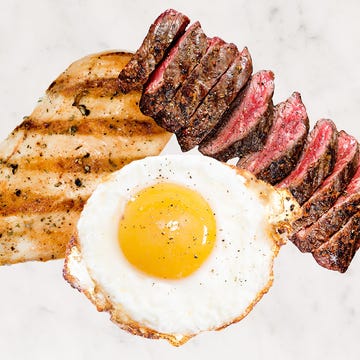We thought we'd seen it all with scrambled egg methods—the additions of orange juice, crème fraîche, baking powder, and corn starch, to name a few—but ask a handful of professional chefs how to make the perfect scrambled eggs and you'll get six new methods to try out at your next brunch.
Anne Burrell
Worst Cooks in America host and chef Anne Burrell knows how to make super sexy soft scrambled eggs. (Her words!) The secret isn't adding cremini mushrooms and melty fontina cheese—it's water.
Instead of adding milk or heavy cream to eggs, Anne goes straight for a tablespoon of water: "It helps get the eggs nice and fluffy. Milk has milk solids that will brown; I want fluffy, light, lemony yellow looking eggs," Anne explained.
Water lightens eggs, making them more mobile, while milk thickens eggs, making them richer. If you want even fluffier eggs, beat them for a little bit longer than usual to add more air into the mixture and you'll be on your way to make Anne-approved scrambled eggs.
Judy Joo
Chef Judy Joo is all about creamy, light, and fluffy scrambled eggs. Her method for fluffy eggs is adding a little bit of heavy cream (remember: heavy cream and fats make thiccc eggs!) to give them a luxurious feel.
Another pro tip: Add Emmental or parmesan cheese with chopped herbs to amp up the flavor of your eggs. Emmental, or Swiss cheese, melts quickly which is perfect when you're up against the clock making breakfast.
Donate to Judy's charity of choice, the Tory Burch Foundation.
Masaharu Morimoto
Iron Chef Masaharu Morimoto's favorite type of scrambled egg is a traditional tamagoyaki—AKA a Japanese rolled omelet. The omelet is made with soy, dashi (a type of broth made from kelp) and dried bonito (flakes of dried skipjack tuna), making the omelet looser so it can be rolled.
The trick to a perfect tamagoyaki is putting a little bit of the egg mixture in at a time, letting it solidify, and then adding more, Morimoto explained. From there, it's all about tucking the fresh mixture under the cooked mixture and a flick of the wrist to make it roll.
Millie Peartree
Restaurateur Millie Peartree started her cooking journey by making scrambled eggs, making this soft scramble recipe near and dear to her heart. "I knew I had an affinity for cooking when I cracked my first egg at six years old," Millie said.
Instead of beating the eggs in a bowl and pouring the mixture into the hot pan, Millie cracks her eggs directly into the hot pan and uses a fork to gently break the yolk. "I don't like it that way, I like the egg white with the creaminess of the yolk."
To add even more richness to her eggs, Millie adds another spoonful of butter and shredded Gruyere once the eggs set: "This is very nostalgic for me, this is very reminiscent of my childhood."
Donate to Millie's fundraiser, Full Heart Full Bellies.
Adam Richman
The first dish Adam Richman ever learned was scrambled eggs as taught to him by his great-aunt. Adam goes for a fluffy egg by using a whisk to beat his eggs and adding milk to give it a velvety texture. "You can get a lot more air into the eggs with the whisk instead of a fork," Adam said.
Another tip to Adam's favorite fluffy eggs: Leave them alone. We know, it sounds counterintuitive, but letting the eggs sit in the hot pan for a moment before stirring gives them more volume, Adam explained. Once you've resisted the urge to fully scramble the eggs into oblivion, Adam also recommends taking the eggs off the heat just before they're finished so they don't overcook. The results are worth it: gorgeous, tender scrambled eggs.
Donate to Adam's charity of choice, No Kid Hungry.
Andrew Zimmern
Bizarre Foods host Andrew Zimmern has two ways to cook scrambled eggs: One is Saturday morning "gotta get the family fed" and the other is Sunday morning "I'm alone in my kitchen and I've got TIME."
For the whole family he makes pillowy, larger curd-eggs with the help of a teaspoon of heavy cream. "In general, the theory is the slower you cook your eggs, the creamier they will be," he notes. Andrew pushes the cooked egg to the center of the pan, letting more egg come into contact with the heat source until they become gentle, soft scrambled eggs.
But when it comes to Sunday and cooking for himself, Andrew takes his time with "super slow, selfish" eggs. The ingredients are the same, four eggs, a teaspoon of cream, salt and pepper—except this time Andrew doesn't turn the heat to medium. It stays on the lowest setting the entire time.
"The curds are going to be more uniform and smaller, so therefore it's going to have a much silkier texture."
After one minute of cooking, the eggs are still in its liquid texture—no curds at all. Twelve minutes later, the fully cooked eggs are so soft, it almost resembles a risotto: "Can you imagine having six children and having to do this? It's why you don't. You keep this skill a secret. This is for yourself."
Donate to one of Andrew's partners & philanthropies here.
Watch the full video on YouTube now.


















